Sharing open-source knowledge: from Do-It-Yourself electronics to artist-run associations
Published 1 September 2024 by Maryia Kamarova
Laureate of the Rewilding Cultures Mobility Conversation grant, belarusian artist Maryia Kamarova attended a residency in several locations in Central France together with artist Pierre Pierre Pierre (aka PPP) dedicated to the development of portable multichannel setup assembled with electret microphones, diy electronics and found objects. Starting in the village of Saint-Arnoult-en-Yvelines, the artists then went to Orléans, to stay in La Labomedia and present their work as part of the Re/Dé}Connecte festival. Maryia recounts her summer on the move for Makery.
Maryia Kamarova is an interdisciplinary artist whose practice is situated on the borders of performing arts, scenography, sound and installation art. She creates spatial settings that foster a sense of curiosity and attention toward everydayness. By staging and technically repurposing mundane objects, the artist emphasizes creative potential of the non-human world. Approaching sound as a performative medium, she continuously develops DIY electro-acoustic objects and lets them temporarily inhabit the sites of performances and installations. Her work has been presented internationally in Europe, Belarus, Ukraine and Mexico.
Preamplifiers, goats and their mutual effects
I remember observing my hands carefully turning it around from one side to another. I was trying to find a bend or at least a hint that this white piece of hard plastic had a different layer, hidden at first glance; so, that I could take it apart and reveal its function, as it sometimes happens with strange useful objects. But it was in vain — my hands were holding a breadboard without holes. “What’s the point,” I thought, “…if it has no holes?”
This remained a mystery. Hours spent above the table with circuit diagrams clearly found their way into my dreams during the quiet nights spent on a countryside. Spoiler: the simplicity of objects such as breadboard does not guarantee their eternal reliability. So, when it comes to prototyping, even with minimal set of employed tools and passion for failures, it is best to ensure their competence.
The first part of our residency took place in the small village of Saint-Arnoult-en-Yvelines, at the private home of Pierre’s friends – musician couple Rachel Langlais and Nicolas Cueille. When searching for a context to meet and continue our collaboration after the first residency in December 2024, Pierre reached out to his network in France (1). He received a positive response from Rachel and Nicolas who offered their place, as well as from La Labomedia, an association based in Orléans, where we headed after a week in the village. We scheduled an appointment for noon on the 12th of June at Paris Bercy Seine, from where we continued towards Vendôme, the nearest train station to our destination.
Rachel and Nicolas’s house had two sound studios, a cozy living room with a vinyl record collection and a library filled with comic books. The musicians were away when we arrived, but they allowed us to use their rooms, garden and car, making it easy to move around the area and do grocery shopping. However, when they returned at the end of our stay, I felt as I already knew them through their music and personal objects guarding their household during the abscence of their owners. There were also other guards – two black goats, who roamed the hillside and occasionally joined us during lunch breaks.
Prior to the residency, we gathered several preamplifier schematics suitable for use with electret microphone capsules and purchased all the necessary materials. I experimented with different electret capsules, starting with some cheap ones I had in my electronics box and moving on to PRIMO EM282 ordered from Micbooster in the UK. The main choice turned out to the capsule issued by PUI Audio (AOM-5024L-HD-R), which sounded good and was readily available from many manufactures in Europe.
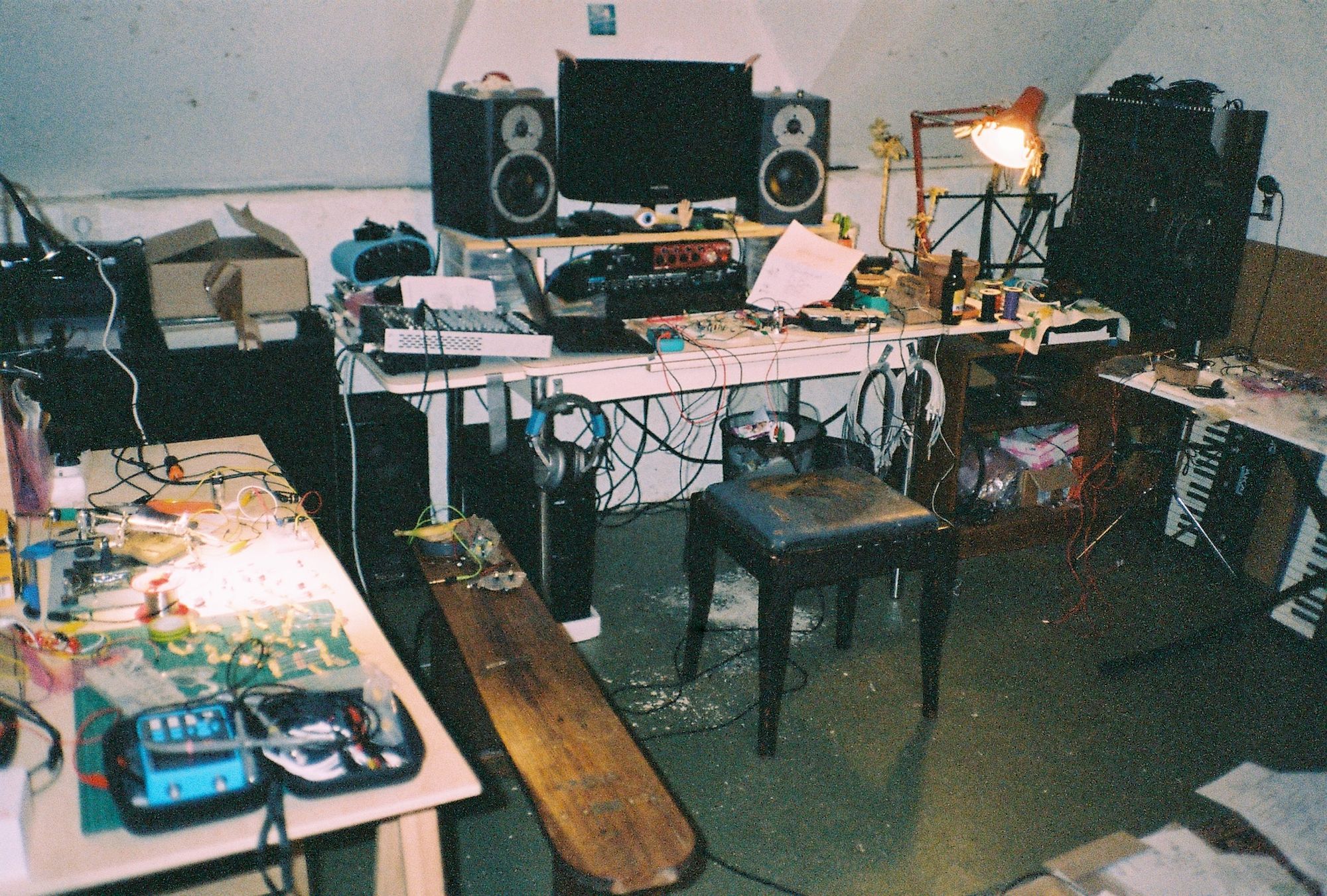
For a couple of days, one of the house studios was transformed into an electronics workshop. Pierre was building a circuit he found on one of the forums (2) based on an op-amp NE5534. I was working on PNP transistor based circuit found in a Graham Bishop’s book on audio circuits (3). We wanted to test several schematics to compare the results and choose the best one for building a prototype on a perfboard. The sounds of the radio and feedback merged with our monologues, me speaking in russian and Pierre talking in french. I imagine that it could be an interesting audio compilation of soundscape electronics workshops, fablabs, hacker spaces, featuring people talking to themselves in fablabs. (which I believe, many of us do while working). In the end, we have chosen an op-amp based circuit.
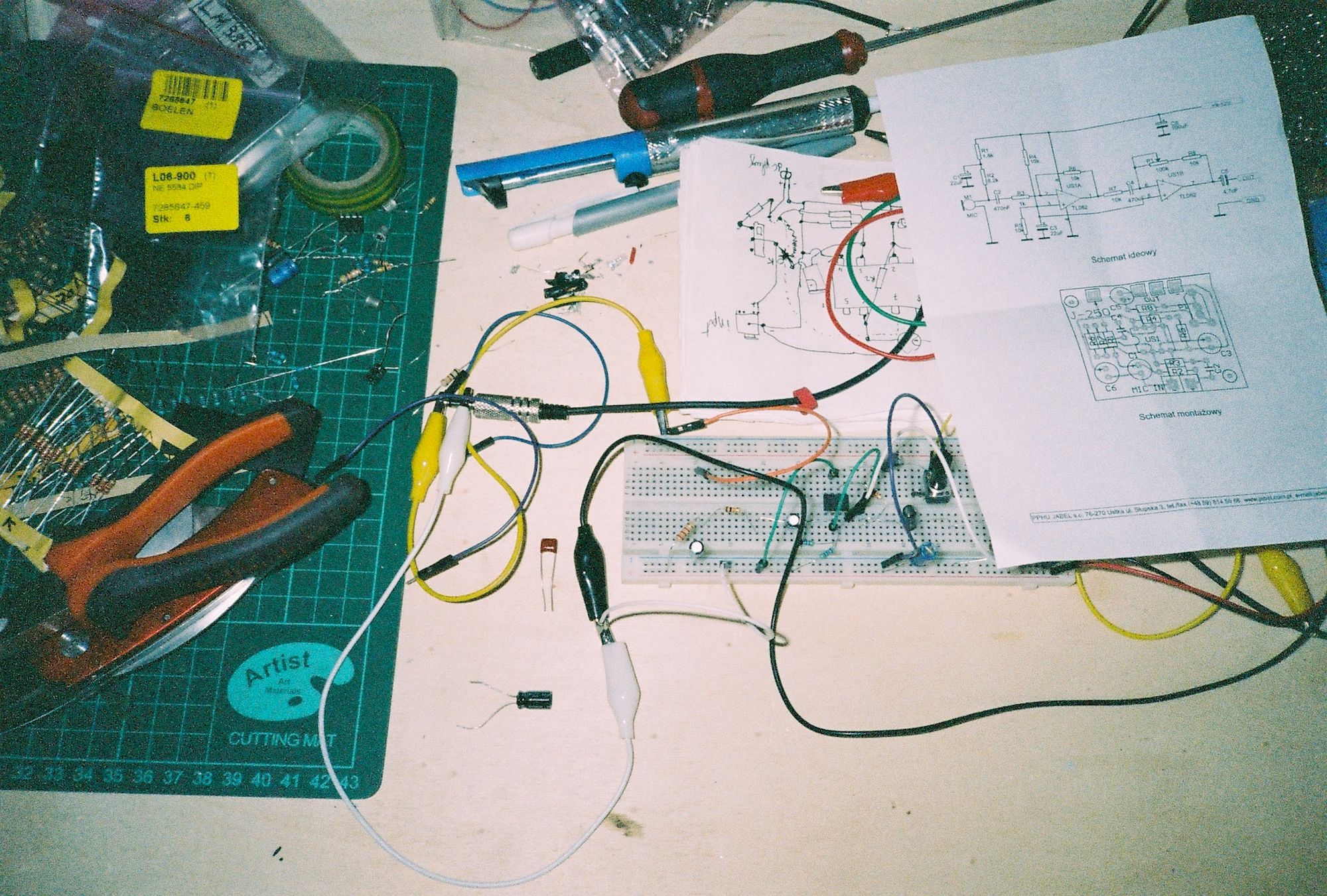
Working towards of our idea about the modular setup for real-time sound capture and reproduction, we aimed to use independent sound objects, each incorporating a microphone, a preamplifier with adjustable gain, an amplifier board, a speaker, and a power supply; replacing with them the omnipresent mixing console, The portability and compact size of these objects allowed for what we called “performative roo(u)ting”, which reffered to an act of moving the objects around the room rather than controlling them with a panoramic knob on a mixer.
The first tests were conducted in Porto in December 2023, in Sonoscopia (4), where we installed our initial improvised setup using an old mixer. With its multiple subgroups, we were able to emulate our system by sending each input channel to a separate output. The sound was produced by assemblages of found objects and small gear motors in a way, allowing us to hear both their acoustic and amplified versions from different places in the room simultaneously. The space resembled a somewhat foley studio for a bizarre mockumentary, with the soundtrack produced in real-time. Small electronic devices mimicked the sounds of footsteps in the forest, knocking of hooves, rustling of wings and screams of weird monkeys, while we stood to the side, adjusting the technology and setting to facilitate the behaviour of the devices.
Minimal gestures achieved with maximum efforts. First we installed the intricate network of cables and integrated circuits to happily listen to the imitation of footsteps in the forest. After, we travelled to a different country, spending a week hunched over half-broken breadboards and then at the soldering station, debugging a circuit commonly available online and deliverable straight to your mailbox. “What’s the point?”, one may question all this action for what might seem like a modest effect. Well, besides having a chance of listening to footsteps in the without any actual trees in your private room, the demanding nature of DIY electronics often yields unexpected results. It enhances in extending our knowledge about things we use and, I believe, fosters a closer and more personal connection with the technology and the materials involved in our creative process.
Both me and Pierre are self-tough in electronics field. I’ve learned (and keep learning) almost intuitively, taking my time and allowing space for failure and imperfection. In moments when one can get surprised by the unexpected behaviour of the object, allowing it to unfold, dynamic interactions occur where we collaborate with the material, treating it as an active agent – a partner and collaborator. What I enjoy most in this niche is precisely these slow and challenging collaborative processes.
Gare à la Rochette!
“What attentiveness to the time of production and engagement with matter reveals is that the production of any artifact is much closer to a negotiation than the simple imposition of a form upon a passive matter. And as is the case with all negotiations, the final outcome or product of the negotiation cannot be said to be the result of a pre-existent and well-defined plan.“
BRYANT, R. Levi. Onto-Cartography. An Ontology of Machines and Media. Edinburgh University Press. 2014.
A few days after the residency, I received a message from Pierre with a link to a product from a French electronics manufacturer: “Look, a legit preamp board with the same op-amp we used.” The board was bigger, mainly due to its stereo configuration and the two large 3300µF capacitors that dominated the design. It costed 49 euros, with a shipping time of two or three days. Within four days, we built several working prototypes, with the material cost for each being less than 4.90 euros. Yet not perfect, they were ready to be tested.
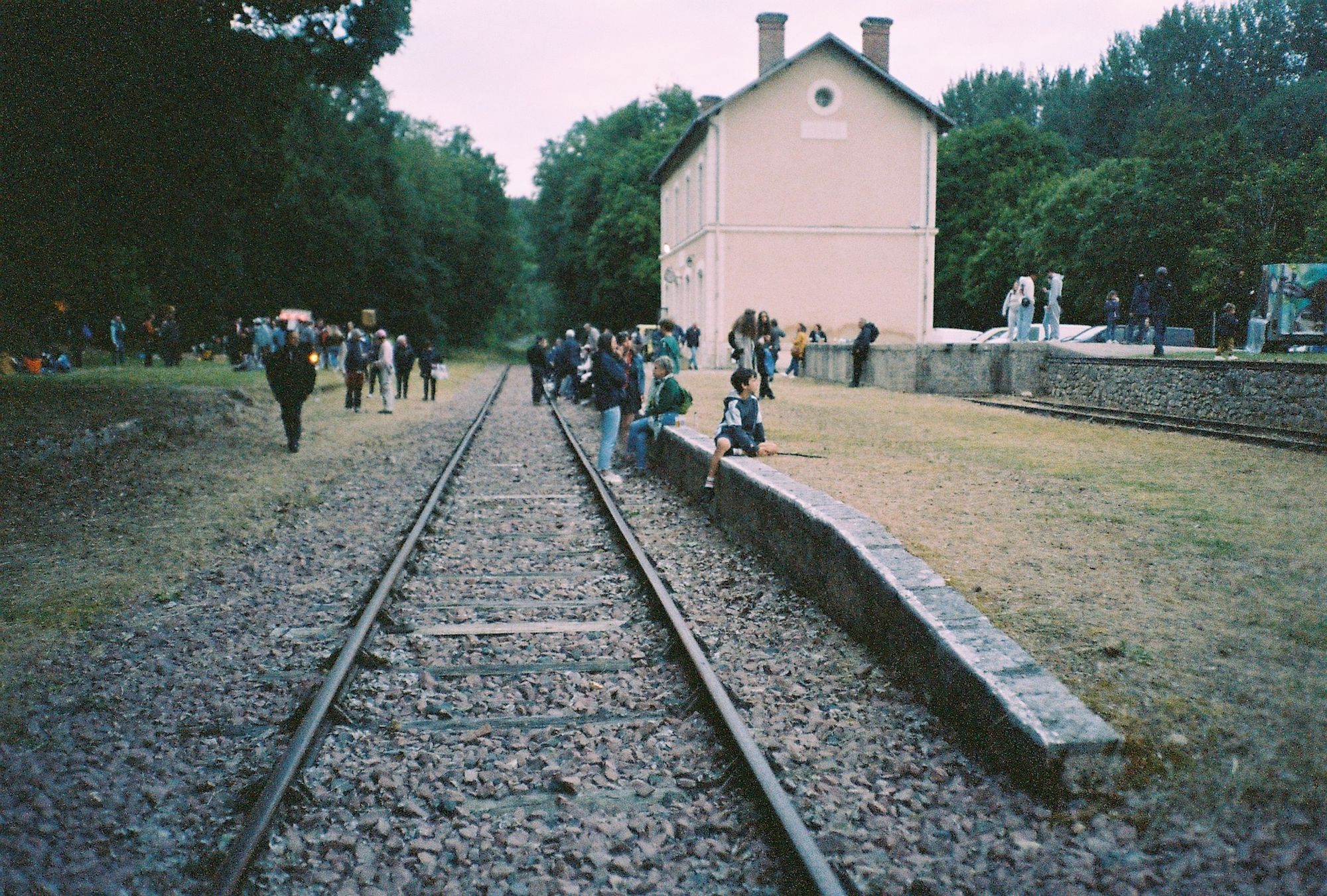
During the week, we had the chance to spend time with our goat friends and attend a festival Gare à la Rochette! happening around the old train station – Thoré-La-Rochette. There, we met Antoine Capet, an artist and maker Pierre knew, who moved to the nearby village from Paris recently and was slowly organizing his activities in a workspace settled on the top floor of the station, just under the attic. He showed us a light room equipped with a laser cutter, 3D printer, and several worktables used during the workshops for local community, which Antoine organises together with his colleague and artists from the area. Simple DIY instruments and other crafted objects were lying on the tables. While having an extensive practice of a specialized educator and being busy with Brut Pop (5), Capet works towards the accessibility of art and music practice in specific communities which he now incorporates in his activities in the place he live.
Rachel and Nicolas arrived on the last day of our stay in Saint-Arnoult, so we could still share a dinner together. Like Antoine, both artists moved to the countryside from larger cities a few years ago. Now, this place offers them a quiet retreat where they can escape the hustle of city life, finding a peaceful environment to rest and focus on their music. For those whose work involves frequent travels and social commitments, having a place to unwind and slowdown is invaluable. Living in countryside has its own advantages: lower living costs, possibility to cultivate personal agriculture, more space and freedom to play music without disturbing the neighbours. Given the current housing situation in cities, this alternative becomes a great survival strategy. On another hand, villages and small towns benefit from growing artistic communities, as they contribute to the development of the local cultural landscape. The next morning, a couple was leaving for Tours, while Pierre and I headed to Orléans for our next destination, La Labomedia. Antoine kindly gave us a lift to the train station.
Infinite Summer – Slow Down. One of a few projects in which the couple of Rachel Langlais and Nicolas Cueille collaborated musically playing ironic R&B and Soul music:
Places to return
Our stay at La Labomedia well corresponded with the dates of their annual festival Re/Dé}Connecte where we were planning to do the first public presentation of our project-in-progress. Located in the city of Orleans, La Labomedia functions as a platform supporting artistic creation, research and digital development in the field of media art. Besides offering a consistent programme of both artistic and educational activities, the assotiations stands for its (h)activism practice and is involved in various projects on the field of digital etics and promotion of open-source knowledge, reaching a very broad audience. One of them, for instance, is FuturÉtic – a francophone digital platform which offers free, ethical, decentralized online tools that prioritize data privacy (6).
Upon our arrival, Benjamin Cadon (one of the founders of La Labomedia) met us directly near the appartment and gave us a quick guide inside the house. After he rushed back to the hub. It was the first festival day and many activities were about to accumulate. The assotiation was located in Le 108 – cultural hub nested in the building of a former choclate factory which among others was giving a room to school workshops, artist ateliers, a social center and other local cultural initiatives.
At Monday’s evening vernisage of SKIPP 99 exhibition, we were approached by Paul Laurent, who invited us to share our project during his Tuesday evening MusicLab Workshop, to which we of course agreed. Over the next days, Pierre and I oscillated between the electronic workshop and a conference room, setting up our installation on a long conference table. We held two presentations, each accompanied by a brief artist talk and space for audience feedback and questions. The first was attended by participants from MusicLab, people aged from 15 to 60 years old, while the second involved a close circle of festival audience and people involved the organization as partners and collaborators. The communal setting allowed us to arrange our devices for live performance while moving around the table with the audience, who could closely observe the manipulations. Some compared this setup to an X-ray or an anatomical theater, where all the parts of the technological “body” were exposed to the observer.
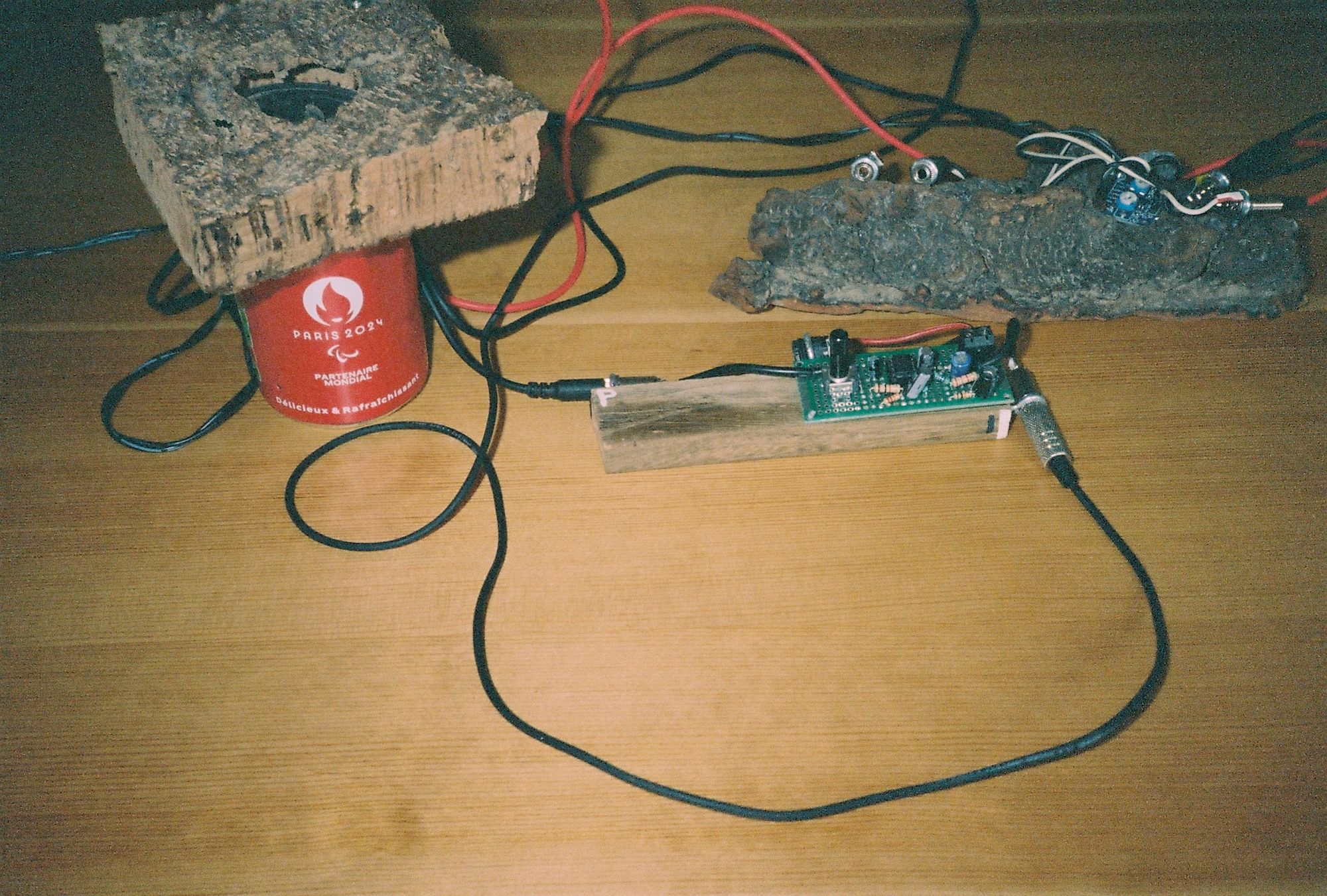
Re/Dé}Connecte festival at La Labomedia attracted a large and diverse audience from the local community and beyond. All events were free of charge, making them accessible to spontaneous visitors passing by the neibhorhood drawn by concerts and sounds of no-input mixings. Combining open studios, dinners, performances and conferences, the program balanced between acts of critical reflection, sharing and presentation.
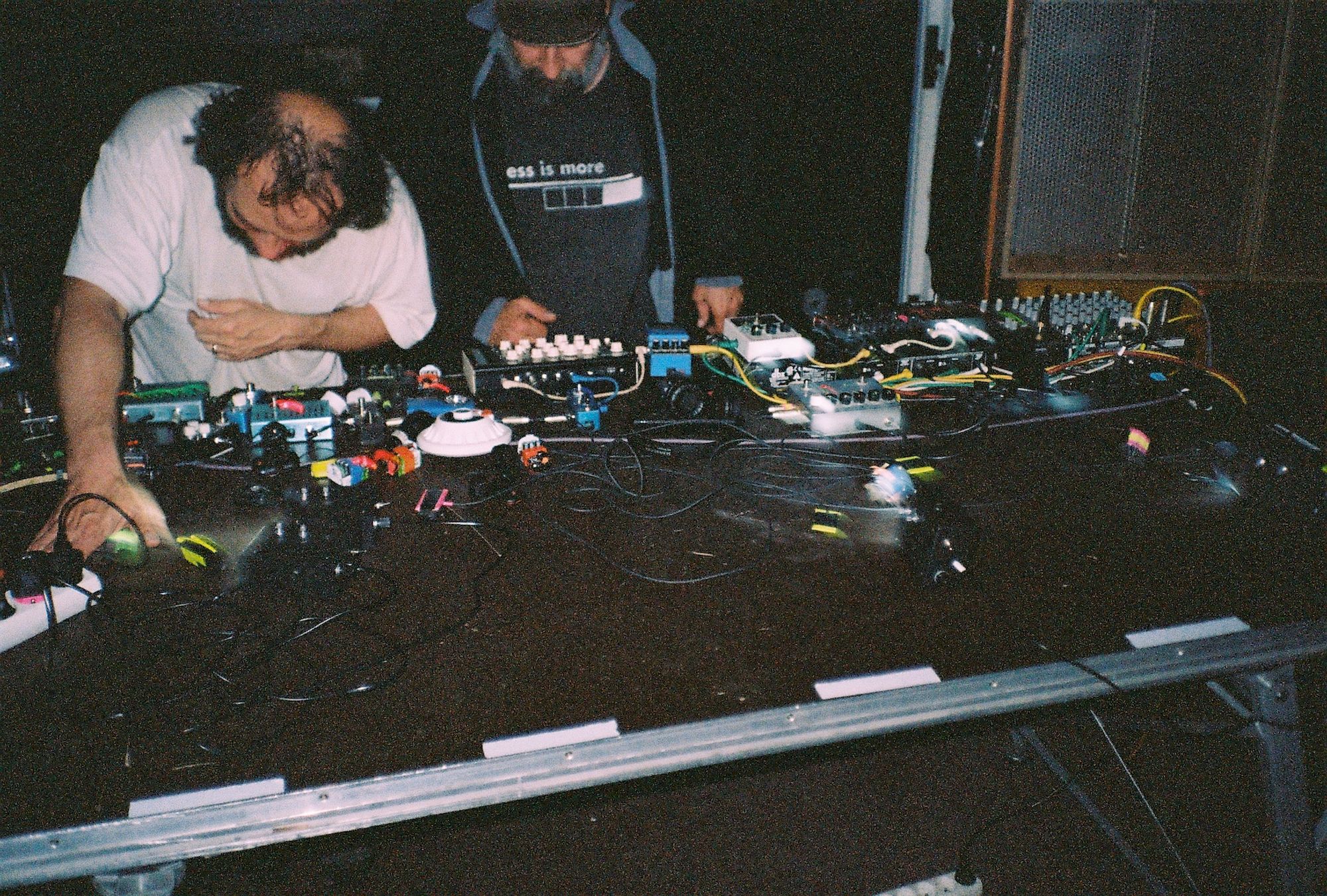
Thursday evening, I attended a lecture by Marie Lechner on lithium extraction in France and other countries, which was her main research subject in recent. Lechner highlighted concerns about the social, ecological, and economic impacts of Europe’s energy transition, questioning the course and matters related to “low-carbon economy.” I was kindly offered a simoulteneous translation by the team and some of the audience. It made me consider the value of hosting such events more often in the evenings, perhaps after shared dinners or even between concerts, opening up the space for reflection and sharing in less expected contexts.
Overall, this stay at (and with) La Labomedia was a great opportunity to advance and share our work, but also to exchange ideas and observe processes of others, getting mutually inspired. As someone who travels frequently, I value the chance to return to places I have visited before. But to return, one must first arrive and spend time there, forming connections with the place and its people.
One such place I recently returned to is Sonoscopia in Porto, from where I am currently writing this report. This is my third time here as a resident, and I have also worked here as an intern in the past (much as Pierre did years ago). When I arrived last Saturday, João Ricardo welcomed me at the door, offered dinner, and showed me the changes at the house. The collection of vintage electronic equipment donated to Sonoscopia between 2022 and 2023 has been beautifully organized into a studio in joint affords of João and Wouter Jaspers. They coordinated the collection and arranged the transport from Germany, as most of the pieces were delivered from there. The synthesizers, oscillators, noise generators, and tape machines were gifts from various people, including Hainbach, Jochen Hänsel, Jaspers himself and the others (7). The rooms on the southern side of the house have been transformed into a library (with many books donated by Vitor Rua), a gallery exhibiting collective works and also a chill room. Previously, this part of the house suffered from a leaky roof, so one or two rooms would flood during the rainy season. When the chill room was empty, I used it to dry objects I found on the coast, since there was getting a lot of natural light. Now, it got some nice plants, a sofa, and a sound system to listen to tapes or just the music from a phone.
Five years ago, when the association moved here from their previous location, the collective had to renovate the entire building, restoring the floors, ceiling, electricity, and water. Now, the shelves are filled with electronic equipment, archives of tapes and records, functional and obsolete media objects, and DIY instruments. And, of course, there is plenty of room for people – artists, touring musicians and residents, visitors and friends of the collective. This will be my base for the next two months (September and October 2024) and a place to continue our collaboration with Pierre.
Few last words
Speaking about the transparency and economy of music making, we often witness a clear hierarchy in what aspects of the processes are presented to the public, what technology and means are visible and what remains behind the curtain. A horizontal approach can be applied and appreciated in that field simmilarily to other community-driven systems. While the act of listening to a concert or watching a performance can be considered entertaining or even immersive, they also create a powerful social context, that we, as creators and organizers, can shape collaboratively with audience and participants. Bringing critical discussion about the contemporary technology to the mass is as important as presenting the ouputs it affords for.
As we navigate the rapidly evolving landscape of multimedia art within the context of an ever-advancing technology market, the importance of sharing skills and knowledge cannot be overstated. In these times of constant innovation, maintaining a balance between our fascination with new tools incorporated into our work and a healthy scepticism toward them is essential. Just as those marginalized by societal systems have developed creative strategies to resist and subvert their limitations, so too must we, as cultural workers, cultivate a critical awareness of the tools at our disposal. Sharing this awareness allows us to harness technology’s potential while remaining vigilant against its pitfalls, ensuring that our work remains both innovative and grounded in ethical practice.
All pictures by the author.
More information on the artistic project and the process of Pierre and Maryia is available via the following link.
Maryia Kamarova was laureate of the 2024 Rewilding Cultures Mobility Conversation grant. Rewilding Cultures is co-funded by the European Union.
notes:
(1) Pierre Pierre Pierre is a self-taught sound artist interested in dysfunctional electronics and situations. He works with handmade electronics, common and cheap hi-fi devices, audio synthesis, and coding software. He has collaborated with various artists and presented his work internationally, with releases on labels like Amateur and Fougère Musique. Formerly a member of Cable# and the Mire experimental cinema collective in Nantes, Pierre now runs 50hz and participates in public space projects with La Méandre and Veiculo Longo. He is also a member of Concerts Dispersés collective which organizes off-grid events and performances in central France region.
(2) Circuit Exchange International. Op-Amp Microphone Preamp: https://www.cxi1.co.uk/Circuits/Audio/lf071_mic.htm
(3) BISHOP, Graham. Audio Circuits and Projects (Revised Edition). Macmillan Education ltd, 1980. ISBN 978-0-333-37221-0. p. 30 (figure 3.2b)
(4) Sonoscopia is an association based in Porto, Portugal, which functions both as an art collective and space for reflection and creative development within the field of sound art and experimental music. The association has existed since 2012 while the collective has been actively involved in the cultural landscape of Portugal and abroad since the late 90’s.
(5) Brut Pop is an artist run association, initiated by Antoine Capet and David Lemoine which is active since 2009 and focused on artistic practice, involving people with mental or psychological disabilities. Activities of the association cover facilitation of sound workshops in care facilities, publications and organisation of various events that intersect art, disability, and reflections on the role of new technologies in social care and healthcare.
(6) FuturÉtic was made primarily for the Centre-Val-de-Loire region but is open and accessible to everyone.
(7) More information about the studio (including the full list of donators).
